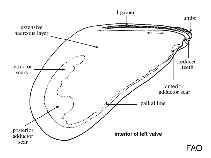Limnoperna fortunei (Dunker, 1856)
Chinese freshwater mussel| Native range | All suitable habitat | Point map | Year 2050 |

|
| This map was computer-generated and has not yet been reviewed. |
| Limnoperna fortunei AquaMaps Data sources: GBIF OBIS |
Google image | No image available for this species;
drawing shows typical species in Mytilidae.
Classification / Names Common names | Synonyms | CoL | ITIS | WoRMS
Bivalvia | Mytilida | Mytilidae
Environment: milieu / climate zone / depth range / distribution range Ecology
Benthic; freshwater; depth range 2 - 19 m (Ref. 116702). Subtropical
Distribution Countries | FAO areas | Ecosystems | Occurrences | Introductions
Western Pacific: China, Korea and Taiwan.
Length at first maturity / Size / Weight / Age
Maturity: Lm ? range ? - ? cm
Life cycle and mating behavior Maturity | Reproduction | Spawning | Eggs | Fecundity | Larvae
Main reference
References | Coordinator | Collaborators
Bernard, F.R., Y.Y. Cai and B. Morton 1993 Catalogue of the living marine bivalve molluscs of China. Hong Kong University Press, Hong Kong. 121 p. (Ref. 75831)
IUCN Red List Status
(Ref. 130435: Version 2025-1)
CITES status (Ref. 108899)
CMS (Ref. 116361)
Threat to humans
Human uses
| FishSource |
Tools
More information
Diet composition
Food consumption
Predators
Max. ages / sizes
Length-weight rel.
Length-length rel.
Length-frequencies
Mass conversion
Abundance
Internet sources
BHL | BOLD Systems | CISTI | DiscoverLife | FAO(Publication : search) | Fishipedia | GenBank (genome, nucleotide) | GloBI | Gomexsi | Google Books | Google Scholar | Google | PubMed | Tree of Life | Wikipedia (Go, Search) | Zoological Record



